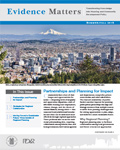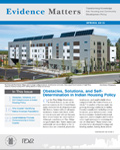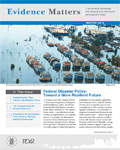| SUMMER/FALL 2015 |

SUMMER/FALL 2015 |
The New Transit Town: Best Practices in Transit-Oriented Development (2004), edited by Hank Dittmar and Gloria Ohland, reviews issues related to transit-oriented development and profiles several examples. islandpress.org/new-transit-town.
-
-
Just Growth: Inclusion and Prosperity in America's Metropolitan Regions (2012), by Chris Benner and Manuel Pastor, explores possible explanations for why and how some regions achieve equitable growth while others do not, including seven detailed case studies. www.routledge.com/products/9780415517812.
-
-
-
Inside Game Outside Game: Winning Strategies for Saving Urban America (1999), by David Rusk, argues that state legislatures should create regional revenue sharing to reduce fiscal disparity among communities, develop regional housing policies to eliminate concentrations of poverty, and use coherent regional land-use planning and growth management to control urban sprawl. www.brookings.edu/research/books/1999/savamr.
Living Cities is a consortium of 22 foundations and financial institutions focused on developing strategies that change the physical and human landscape of cities to improve the lives of low-income people, focusing on affordable housing in transit corridors, reimagining education to build cradle-to-career systems, and reducing youth recidivism. The Living Cities website hosts resources related to these and other relevant topics. www.livingcities.org/resources.
Smart Growth America supports the creation and maintenance of healthy communities that have a range of housing, transportation, employment, and retail options through cutting edge research, policy development, and coalition building. www.smartgrowthamerica.org/.
The Metropolitan Revolution: How Cities and Metros Are Fixing Our Broken Politics and Fragile Economy, by Bruce Katz and Jennifer Bradley, highlights metropolitan areas that are taking it upon themselves to develop successful economic strategies that address 21st century challenges. metrorevolution.org/.
-
Back to top
|
| SPRING 2015 |

SPRING 2015 |
-
“Nation to Nation: Treaties Between the United States and American Indian Nations” is an exhibit running through fall 2018 at the National Museum of the American Indian that explores the history of U.S. – Native American diplomacy. www.nmai.si.edu/explore/exhibitions/item/?id=934.
-
-
-
-
“Assessment of Native American, Alaska Native, and Native Hawaiian Housing Needs” (forthcoming), by the Urban Institute, will use survey data, interviews with tribal leaders, and analysis of secondary data to provide a clear and credible picture of housing conditions in Indian Country. www.huduser.gov/portal/native_american_assessment/home.html.
-
“Access to Capital and Credit in Native Communities” (forthcoming), by the Community Development Financial Institutions Fund, will detail challenges to expanding credit in Indian Country, the role of the private sector, how financing mechanisms have shaped housing, and how to improve legal institutions to foster credit access. www.cdfifund.gov/what_we_do/Native_Communities_Study.asp.
-
American Indians, Time, and the Law: Native Societies in a Modern Constitutional Democracy (1987), by Charles Wilkinson, examines the complexity and contradictions in the development of Indian law and the effect of federal court decisions on tribal sovereignty. yalepress.yale.edu/yupbooks/book.asp?isbn=9780300041361.
-
-
American Indian Sovereignty and the U.S. Supreme Court: The Masking of Justice (2010), by David Wilkins, argues that the Supreme Court has selectively applied legal precedent in cases involving Native American rights, curtailing tribal sovereignty, and legitimizing the loss of tribal land. utpress.utexas.edu/index.php/books/wilame.
-
American Indian Treaties: The History of a Political Anomaly (1994), by Francis Paul Prucha, provides a comprehensive history of treatymaking between the United States and Native Nations, tracing the impact of treaties on today’s legal landscape. www.ucpress.edu/book.php?isbn=9780520208957.
-
Uneven Ground: American Indian Sovereignty and Federal Law (2001), by David E. Wilkins and K. Tsianina Lomawaima, discusses the history of political rights held by Native Nations as well as federal efforts to uphold, ignore, modify, or terminate them. www.oupress.com/ECommerce/Book/Detail/1246/Uneven%20Ground.
-
Social Change and Cultural Continuity among Native Nations (2006), by Duane Champagne, provides a framework for understanding the societal changes experienced by Native Nations as well as prospects for cultural continuity in the twenty-first century. rowman.com/isbn/075911000X.
-
American Indian Constitutional Reform and the Rebuilding of Native Nations (2006), edited by Eric Lemont, is a collection of articles by academics, tribal leaders, and practitioners on constitutional reform efforts in Native Nations. utpress.utexas.edu/index.php/books/lemame.
-
Reservation “Capitalism”: Economic Development in Indian Country (2012), by Robert J. Miller, provides an overview of tribal economies and discusses strategies for building economically sustainable and self-sufficient Native American communities. www.abc-clio.com/ABC-CLIOCorporate/product.aspx?pc=A3778C.
-
Back to top
|
| WINTER 2015 |

WINTER 2015 |
-
The Social Roots of Risk: Producing Disasters, Promoting Resilience (2014), by Kathleen Tierney, examines the intersection of natural disasters and the social order; in particular, how social systems and institutions affect risk. www.sup.org/books/title/?id=18573.
-
Disaster Resiliency: Interdisciplinary Perspectives (2012), edited by Naim Kapucu, Christopher V. Hawkins, and Fernando I. Rivera, investigates the concept of disaster resilience and the factors that contribute to resilience at the local level from various methodological and disciplinary perspectives. www.routledge.com/books/details/9780415626897/.
-
-
Designing Resilience: Preparing for Extreme Events (2010), edited by Louise K. Comfort, Arjen Boin, and Chris C. Demchak, explores the development of structural and nonstructural resilience in the context of several different types of hazards. www.upress.pitt.edu/BookDetails.aspx?bookId=36086.
-
“Resilient Communities: Empowering Older Adults in Disasters and Daily Life” (2014), by Lindsay Goldman et al., examines the experiences of older adults and their communities during Hurricane Sandy and applies a community resilience framework to make recommendations for ensuring that older adults are connected to and participating in support systems before a disaster occurs. www.nyam.org/news/docs/pdf/Resilient_Communities_Report_Final.pdf.
-
-
U.S. Geological Survey Natural Hazards Science Strategy — Promoting the Safety, Security, and Economic Well-Being of the Nation (2013), by Robert R. Holmes, et al., outlines a science-based strategy for improving national resilience to natural hazards. pubs.usgs.gov/circ/1383f/. Additionally, the U.S. Geological Survey website provides a wealth of information regarding natural hazards and vulnerabilities including those related to climate and land use change. www.usgs.gov/natural_hazards/.
-
The Natural Hazards Center of the University of Colorado at Boulder’s website contains a range of disaster-related resources, including the center’s own research and publications as well as topically organized and annotated bibliographies. www.colorado.edu/hazards/.
-
The Office of Policy Development and Research’s Disaster Recovery Tool Kit hosts an array of relevant print and video disaster recovery resources. www.huduser.gov/portal/sandy.html.
-
Rotterdam Climate Initiative is a climate change adaptation effort by Rotterdam, a delta city below sea level whose economy depends on water transportation, to become the most sustainable port city in the world. www.rotterdamclimateinitiative.nl/en.
-
The European Union’s FloodResilienCity project is funding and developing flood mitigation and resilience infrastructure in six European countries in cooperation with local government. www.floodresiliencity.eu/.
Back to top
|

